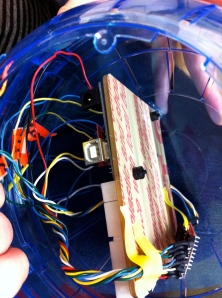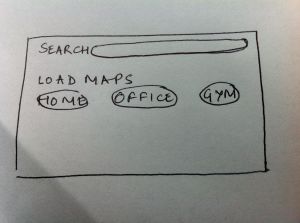FINAL PROJECT – AUDIO BALL
For our final project, we took the Audio Ball to the next level. We conceive the audio ball as a performative tool for musicians/ an object to throw around and have fun at a party and for personal creative endeavours with music.
The Audio ball is now wireless (we used bluetooth). The accelerometer- gyroscope combination remains the same. We made two of these balls. Another feature is the addition of LEDs inside the balls that change according to the motion of the ball.
In this part of the project, I specifically worked on the audio visualization component. My concept was to make an environment with already existing patterns of movement and have the movement of the balls interrupt/disturb/cause chaos in some way. It went well with the aesthetics of the ball and the sound samples we used. I used Processing to create an array of 3D cubes suspended in along uniform rows and columns and gave them two kinds of motion- a wave motion, and an individual random motion. Then I mapped the gyroscopic movements of the ball to interrupt that pattern by altering the rotation angle of each cube.
Before I arrived at this, I played around with FFT + OPENGL but quickly realized that the approach to let random values decide patterns of motion was not necessarily aesthetically appealing. Even after calibrating those results, the patterns were either too arbitrary or too interpretive of real motion. I decided to go with the former and conceptually flesh out an alternative idea. I was interested in the idea of sound as it exists in nature as wave patterns that consume disturbances. My audio visualization goes against this rule and breaks the smooth patterns each time an alien sound appears.
Final Project
For the final project, we are going a step further with the Media Controller midterm project. The plan is to have multiple balls and make them wireless and have them interact with each other and the user. It becomes a piece for performance where the performer plays with these balls to mix sounds as she likes. The ideal scenario would be for a juggler to use it to supplement her act with music. To start off, we are trying to work with wireless and thinking about using different balls for different kinds of preset audio.
MIDTERM
For the midterm, Allison, Michael and I got together for a media controller that would somehow manipulate sound. After some deliberation, we came to the idea of an audio ball whose motions would cause the sound to alter in different ways. We used an accelerometer-gyroscope for this.
Here are some pictures
Observation: Card reader enabled door opening systems
I haven’t encountered a single flawless card reader ever since I have started using them i.e. ever since they have been in existence. There are several problems. The first is, it’s never clear which way one needs to swipe the card. Touch systems that use RFID are a little better but in my experience, they tend to falter too. There is no clear protocol- banks, transport systems, institutional ids all seem to have different cards and different readers. It is difficult to remember which one works which way, especially when all these must be used in the public, often causing inconvenience to self and the queue behind that is ready to hastily show you “how it’s done.’
ATM card door open activation systems may be useless – I have always sort of known this but seeing it happen again and again has almost convinced me that those ATM card door open activation systems may be entirely useless, and at best, give one a false sense of security. The purpose is almost always defeated at the cost of social courtesy which makes people open/hold/ close doors for them all the time- be it the ATM, the restaurant or your elevator building. So unless you look like you’re out to cause some heavy damage, you will probably get an easy entry anywhere without really being ‘allowed’ entry.
Going by Norman and Crawford’s writings, card readers fail on two crucial design parameters. The first that they are immensely confusing to their users and are routine sources of embarrassment, aggravation and queues. Almost all of us will recall at least one instance of having missed a train because someone in the queue or they themselves couldn’t get the card read. The second, inasmuch as id card entry provides some sense of security (say entrances to banks etc), the technological sensibility of the city clearly fails when it collides with the social sensibility. Card readers need to be made better and there need to be fewer of them.
Stupid Pet Trick
Here are a couple of videos demonstrating the use of an FSR. The idea is to use it as a snap detector for one of those fragile paper bags- the force exerted by the weight of the paper bag is sensed by the FSR which then causes the LED to blink brighter (if heavy) or dimmer (if not so heavy). The problem though is that FSR readings refuse to be calibrated- they are pretty inconsistent every time I run the program.
FSR TEST
It Works!
Analog Readings
And the Code-
int fsrAnalogPin = 0; // the FSR and 10K pulldown are connected to a0
int fsrReading; // the analog reading from the FSR resistor divider
int LEDpin= 11;
int LEDbrightness;
void setup(void) {
// We'll send debugging information via the Serial monitor
Serial.begin(9600);
pinMode(11,OUTPUT);
}
void loop(void) {
fsrReading = analogRead(0);
Serial.print("Analog reading = ");
Serial.print(fsrReading); // the raw analog reading
Serial.print(LEDbrightness);
LEDbrightness = map(fsrReading, 688, 900, 0, 255);
//analogWrite(13, LEDbrightness);
analogWrite(11, LEDbrightness);
delay(100);
// We'll have a few threshholds, qualitatively determined
if (fsrReading ==0) {
Serial.println(" - No pressure");
} else if (fsrReading < 680) {
Serial.println(" - Not bad");
} else if (fsrReading < 750) {
Serial.println(" -Can go a little bit more");
} else if (fsrReading < 800) {
Serial.println(" - Uh Oh");
} else {
Serial.println(" - Ohhh Nooo STOP");
}
}
Fantasy Device
This is not as fantastical as the title would lead one to believe. But personally, I need this. And I know many people who need this more than me. Losing important things is one of my greatest day to day fears; one that I combat by checking that I have the three essentials(phone, keys,wallet) at least three times before exiting a room.
My device is simple. It puts the three essentials (or more) on an LPS network so they can talk to each other. They can also talk to a parent device that can store local, object based maps of the places that you are most likely to leave something behind- your home, office, the gym, a favourite restaurant etc.
The parent device interface looks something like this.
A search would look something like this-
For those who tend to lose things or leave them behind, there is one problem that should’ve been obvious by now. What happens if you lose the parent device?! Well, hopefully you will still have at least one of the items on the network which will be programmed to either emit sound/light when another item on the same network is within 10 ft . And if you aren’t missing your smartphone, you can hook that up to locate your missing object on a map.
TALK TO ME@MOMA- “CAN YOU HEAR ME? I CAN HEAR YOU”
One of the takeaways from this exercise was to realize the importance of space within the context of interactivity and what implications it might have to the very concept. The exhibition presents a slew of objects underlining the curatorial impulse to categorize – there were ‘art’ objects (of course, they HAVE to come first in a Museum!), then there were utilitarian pieces (commercial and individual interest projects) and then there were some that were likely both. The fact that one should experience these potentially stimulating works in an old fashioned museum setting where one is ‘never allowed to touch’ or even come close meant that ‘interactivity’ was limited to using earphones connected to the work.
To think of interactivity as, well, ‘inter-activity’, implies a certain amount of ‘activity’ for each party. If one were to go by Crawford’s idea of interactivity, interactivity involved fairly simple steps broken down into – listening, thinking and speaking for both parties. To analyze a show such as Talk To Me- interactivity perhaps need to be decoded a little more. I propose to do this with three specific examples.
1) Dead Drops (Aram Bartholl)- Aram Bartholl’s project is an experience in delayed interactivity. There is something within the nature of the idea of interactivity that assumes a simultaneous set of interconnected dialogue. Bartholl’s project almost simulates an intangible signal in space- yours to own and use at your wish. Only Bartholl uses physical objects- USB sticks- to create layers and layers of connectivity over space and time- not all of which can be bracketed within a three tier network of – listening, thinking and speaking.
2) Immaterials (Timo Arnall and Einar Sneve Martinussen)- The interesting thing about this project is its attempt to decode interactivity itself without being interactive in any which way. A video takes us on a vibrant color project showcasing RFID interaction.
3) E-Chromi (James King and Alexanrda Daisy)- My absolute favourite in the show was E-Chromi. A brief from the project page ” The patient ingests a drink, much like a probiotic shake, laced with the engineered E. coli; the bacteria react with the enzymes, proteins, and other chemicals that are present in the gastrointestinal tract and turn different colors for different diseases, thus changing the color of the patient’s feces. These colors are presented in King and Ginsberg’s Scatalog, a collection of samples in a briefcase that demonstrate an array of E. chromi results in immediate visual terms.” What is most interesting to me is the concept of interactivity that goes beyond neurons and synapses and works with basic bodily signals to then create an interactive interface to better understand one’s own condition. This mediation between different forms of interactivity across different elements and media is interesting to think about in terms of a convergence of what ‘interactivity’ might mean for different platforms.



